EXHIBIT 99.2
Published on September 30, 2025
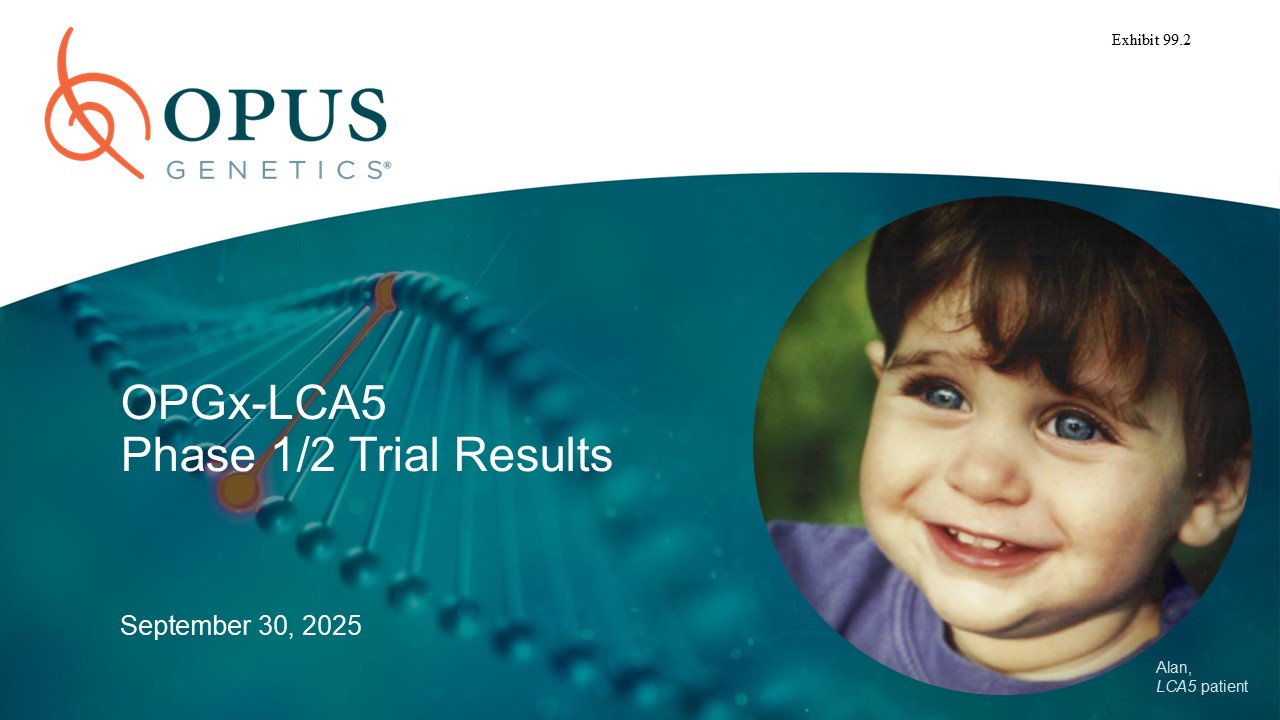
OPGx-LCA5 Phase 1/2 Trial Results September 30, 2025 Alan,LCA5
patient Exhibit 99.2

This presentation contains forward-looking statements within the meaning of the
Private Securities Litigation Reform Act of 1995. Such statements include, but are not limited to, statements concerning data from and future enrollment for our clinical trials and our pipeline of additional indications. These forward-looking
statements relate to us, our business prospects and our results of operations and are subject to certain risks and uncertainties posed by many factors and events that could cause our actual business, prospects and results of operations to
differ materially from those anticipated by such forward-looking statements. Factors that could cause or contribute to such differences include, but are not limited to, those described under the heading “Risk Factors” included in our Annual
Report on Form 10-K for the fiscal year ended December 31, 2024 and our Quarterly Reports on Form 10-Q for the fiscal quarters ended March 31, 2025 and June 30, 2025 and in our other filings with the U.S. Securities and Exchange Commission
(the “SEC”). Readers are cautioned not to place undue reliance on these forward-looking statements, which speak only as of the date of this presentation. In some cases, you can identify forward-looking statements by the following words:
“anticipate,” “believe,” “continue,” “could,” “estimate,” “expect,” “intend,” “aim,” “may,” “ongoing,” “plan,” “potential,” “predict,” “project,” “should,” “will,” “would” or the negative of these terms or other comparable terminology,
although not all forward-looking statements contain these words. We undertake no obligation to revise any forward-looking statements in order to reflect events or circumstances that might subsequently arise. These forward-looking statements
are based upon our current expectations and involve assumptions that may never materialize or may prove to be incorrect. Actual results and the timing of events could differ materially from those anticipated in such forward-looking statements
as a result of various risks and uncertainties, including, without limitation: our clinical data related to gene therapies for the treatment of inherited retinal diseases is preliminary and related to a relatively small group of patients,
and, as a result, data that initially appears promising may be revised, updated, or invalidated at a later data readout and/or may ultimately not be capable of duplication in additional patients; failure to successfully integrate our
businesses following our acquisition of former Opus Genetics Inc. (the “Opus Acquisition”) could have a material adverse effect on our business, financial condition and results of operations; the Opus Acquisition significantly expanded our
product pipeline and business operations and shifted our business strategies, which may not improve the value of our common stock; our gene therapy product candidates are based on a novel technology that is difficult to develop and
manufacture, which may result in delays and difficulties in obtaining regulatory approval; our planned clinical trials may face substantial delays, result in failure, or provide inconclusive or adverse results that may not satisfy FDA
requirements to further develop our therapeutic products; delays or difficulties associated with patient enrollment in clinical trials may affect our ability to conduct and complete those clinical trials and obtain necessary regulatory
approvals; changes in regulatory requirements could result in increased costs or delays in development timelines; we depend heavily on the success of our product pipeline; if we fail to find strategic partners or fail to adequately develop or
commercialize our pipeline products, our business will be materially harmed; others may discover, develop, or commercialize products similar to those in our pipeline before or more successfully than we do or develop generic variants of our
products even while our product patents remain active, thereby reducing our market share and potential revenue from product sales; we do not currently have any sales or marketing infrastructure in place and we have limited drug research and
discovery capabilities; the future commercial success of our products could significantly depend upon several uncertain factors, including third-party reimbursement practices and the existence of competitors with similar products; product
liability lawsuits against us or our suppliers or manufacturers could cause us to incur substantial liabilities and could limit commercialization of any product candidate that we may develop; failure to comply with health and safety laws and
regulations could lead to material fines; we have not generated significant revenue from sales of any products and expect to incur losses for the foreseeable future; our future viability is difficult to assess due to our short operating
history and our future need for substantial additional capital, access to which could be limited by any adverse developments that affect the financial services markets; raising additional capital may cause our stockholders to be diluted,
among other adverse effects; we operate in a highly regulated industry and face many challenges adapting to sudden changes in legislative reform or the regulatory environment, which affects our pipeline stability and could impair our ability
to compete in international markets; we may not receive regulatory approval to market our developed product candidates within or outside of the U.S.; with respect to any of our product candidates that receive marketing approval, we may be
subject to substantial penalties if we fail to comply with applicable regulatory requirements; our potential relationships with healthcare providers and third-party payors will be subject to certain healthcare laws and regulations, which
could expose us to extensive potential liabilities; we rely on third parties for material aspects of our business, such as conducting our nonclinical and clinical trials and supplying and manufacturing bulk drug substances, which exposes us
to certain risks; we may be unsuccessful in entering into or maintaining licensing arrangements (such as our license agreement with Viatris, Inc.) or establishing strategic alliances on favorable terms, which could harm our business; our
current focus on the cash-pay utilization for future sales of RYZUMVI may limit our ability to increase sales or achieve profitability with this product; inadequate patent protection for our product candidates may result in our competitors
developing similar or identical products or technology, which would adversely affect our ability to successfully commercialize; we may be unable to obtain full protection for our intellectual property rights under U.S. or foreign laws; we may
become involved in lawsuits for a variety of reasons associated with our intellectual property rights, including alleged infringement suits initiated by third parties; we are dependent on our key personnel, and if we are not successful in
attracting and retaining highly qualified personnel, we may not be able to successfully implement our business strategy; as we grow, we may not be able to operate internationally or adequately develop and expand our sales, marketing,
distribution, and other corporate functions, which could disrupt our operations; the market price of our common stock is expected to be volatile; our common stock may be subject to delisting from the Nasdaq Capital Market, which could
adversely affect our ability to access capital markets; factors out of our control related to our securities, such as securities litigation or actions of activist stockholders, could adversely affect our business and stock price and cause us
to incur significant expenses; and our business could experience an adverse impact from current or proposed tariffs on imported goods we purchase. The foregoing review of important factors that could cause actual events to differ from
expectations should not be construed as exhaustive. Readers are urged to carefully review and consider the various disclosures made by us in this report and in our other reports filed with the SEC that advise interested parties of the risks
and factors that may affect our business. All forward-looking statements contained in this presentation speak only as of the date on which they were made. We undertake no obligation to update such statements to reflect events that occur or
circumstances that exist after the date on which they were made. Disclosures and Forward-Looking Statements 2

Management Team Call Participants George Magrath, MD, MBA, MS Chief Executive
Officer Ben Yerxa, PhD President Ash Jayagopal, PhD, MBA Chief Scientific & Development Officer Sally Tucker, PhD Senior Vice President, Clinical Development 3 Rob Gagnon, CPA, MBA Chief Financial Officer
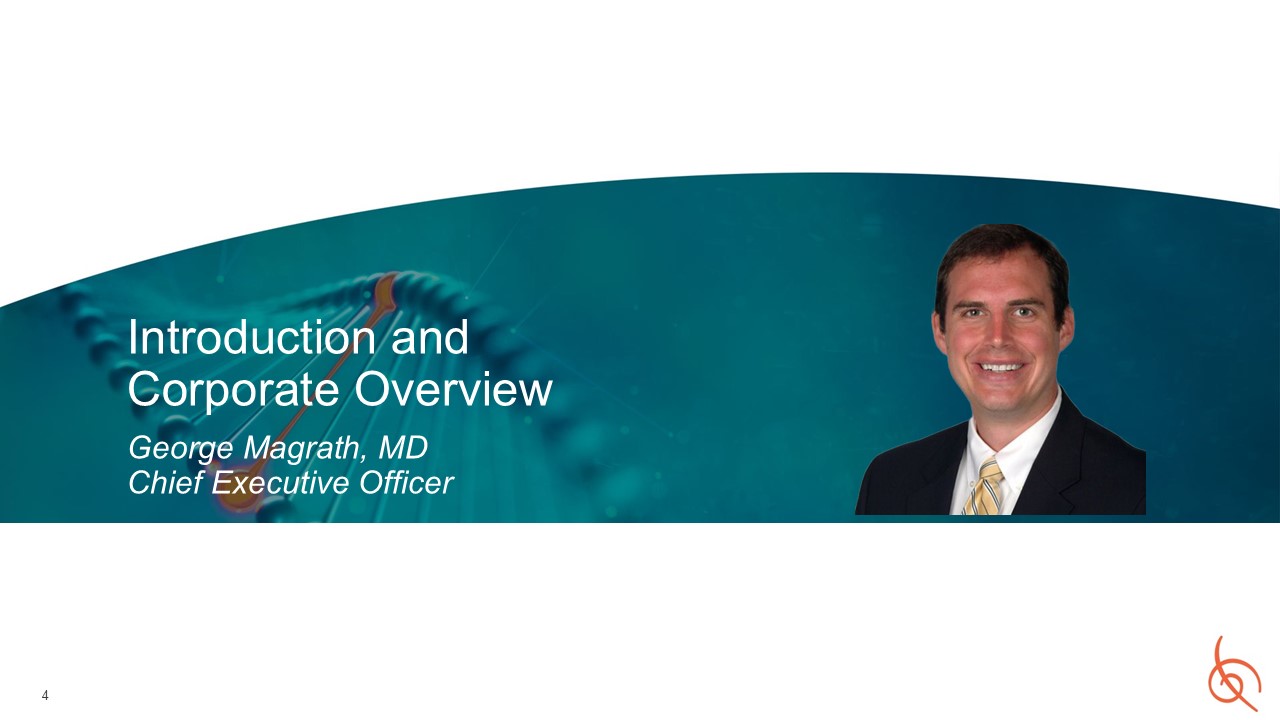
4 Introduction andCorporate OverviewGeorge Magrath, MDChief Executive
Officer 4
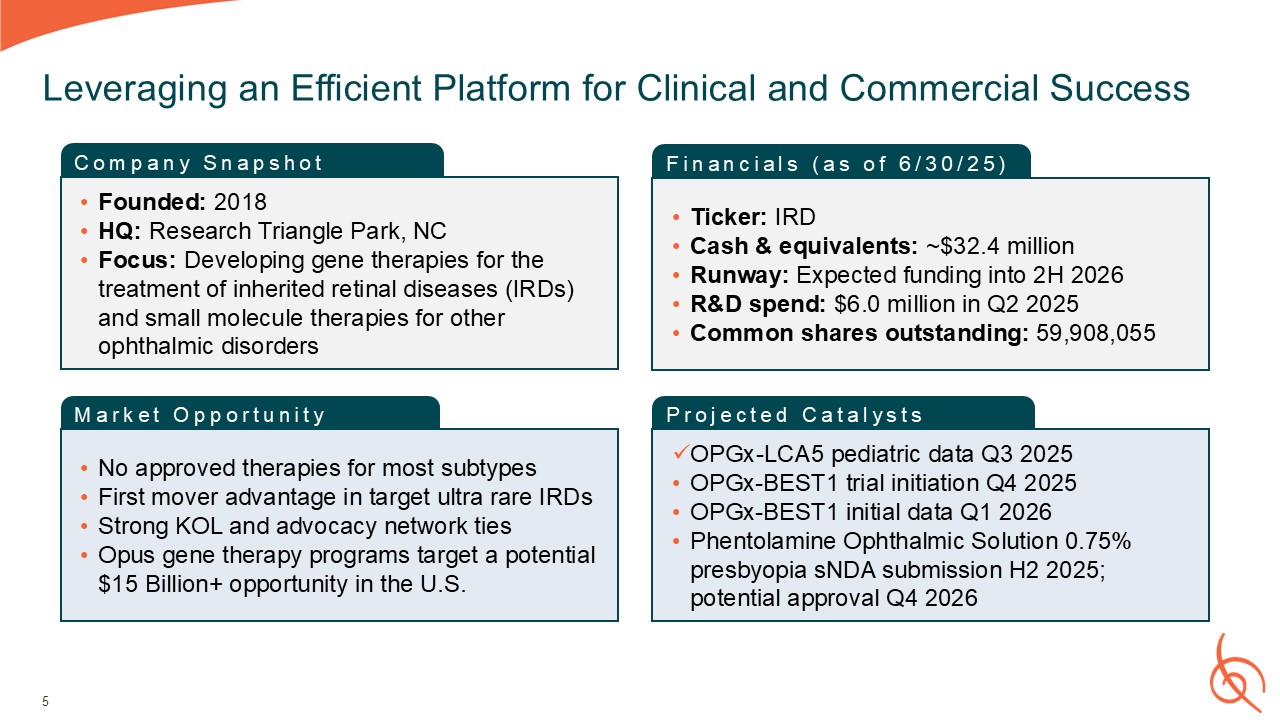
Leveraging an Efficient Platform for Clinical and Commercial Success Founded:
2018 HQ: Research Triangle Park, NC Focus: Developing gene therapies for the treatment of inherited retinal diseases (IRDs) and small molecule therapies for other ophthalmic disorders Company Snapshot No approved therapies for most
subtypes First mover advantage in target ultra rare IRDs Strong KOL and advocacy network ties Opus gene therapy programs target a potential $15 Billion+ opportunity in the U.S. Market Opportunity OPGx-LCA5 pediatric data Q3
2025 OPGx-BEST1 trial initiation Q4 2025 OPGx-BEST1 initial data Q1 2026 Phentolamine Ophthalmic Solution 0.75% presbyopia sNDA submission H2 2025; potential approval Q4 2026 Projected Catalysts Financials (as of 6/30/25) Ticker:
IRD Cash & equivalents: ~$32.4 million Runway: Expected funding into 2H 2026 R&D spend: $6.0 million in Q2 2025 Common shares outstanding: 59,908,055 5

U.S. Prevalence Preclinical IND-enabling Phase 1/2 Phase 2/3 Rare
Pediatric Orphan Drug Status OPGx-LCA5 LCA ~200 patients1,2 Granted 3-month pediatric & 18-month adult data in Q3 2025 Co-funded by FDA OOPD OPGx-BEST1 Bestrophinopathies ~9,000 patients1,2 Eligible Initiate clinical trial in
Q4 2025 Initial data expected Q1 2026 Future IRD Programs OPGx-RHO adRP ~5,600 patients2 Eligible IND-enabling studies Co-funded by FFB & NIH OPGx-RDH12 LCA ~1,100 patients1,2 Eligible IND-enabling studies Co-funded by
Global RDH12 Alliance OPGx-MERTK RP ~600 patients1 Eligible IND-enabling studies Co-funded by FFB RD Fund OPGx-NMNAT1 LCA ~800 patients1 Eligible Pre-IND OPGx-CNGB1 RP ~400 patients1 Granted Pre-IND NIH-funded
consortium Efficient IRD Pipeline with Multiple Near-Term Value Inflection Points Anticipated 6 1. Stone et al. Ophthalmology. 2017;124:1314-1331. 2. Triangle Insights Group market research (compilation of prevalence studies), conducted
August 2023. Lead Candidates adRP, autosomal dominant retinitis pigmentosa; BEST1, bestrophin 1; CNGB1, cyclic nucleotide-gated channel β1; FDA, Food and Drug Administration; GLP, Good Laboratory Practices; IND, Investigational New Drug;
IRD, inherited retinal disease; LCA, Leber congenital amaurosis; MERTK, MER proto-oncogene tyrosine kinase; NHP, nonhuman primate; NMNAT1, nicotinamide mononucleotide adenylyltransferase 1; ODD, Orphan Drug Designation; RDH12, retinol
dehydrogenase 12; RHO, rhodopsin; RP, retinitis pigmentosa; RPDD, Rare Pediatric Disease Designation; FFB, Foundation Fighting Blindness; FDA OOPD, Office of Orphan Products Development
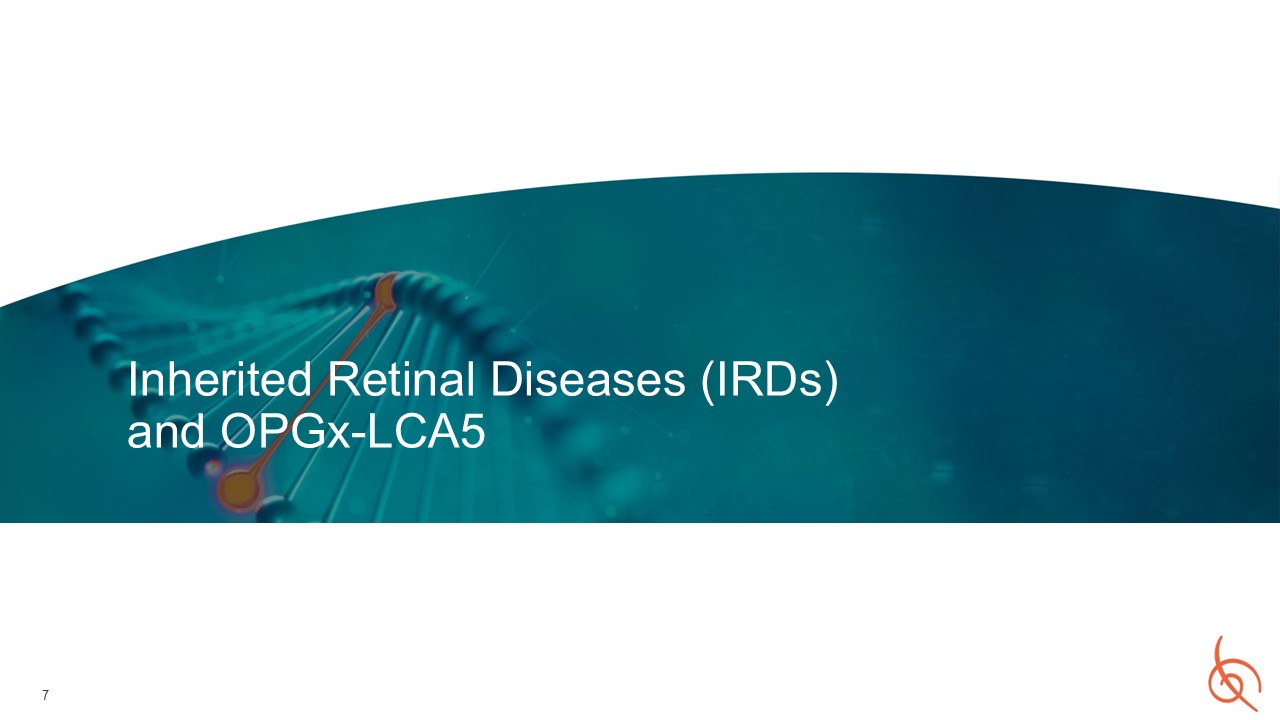
7 7 Inherited Retinal Diseases (IRDs) and OPGx-LCA5
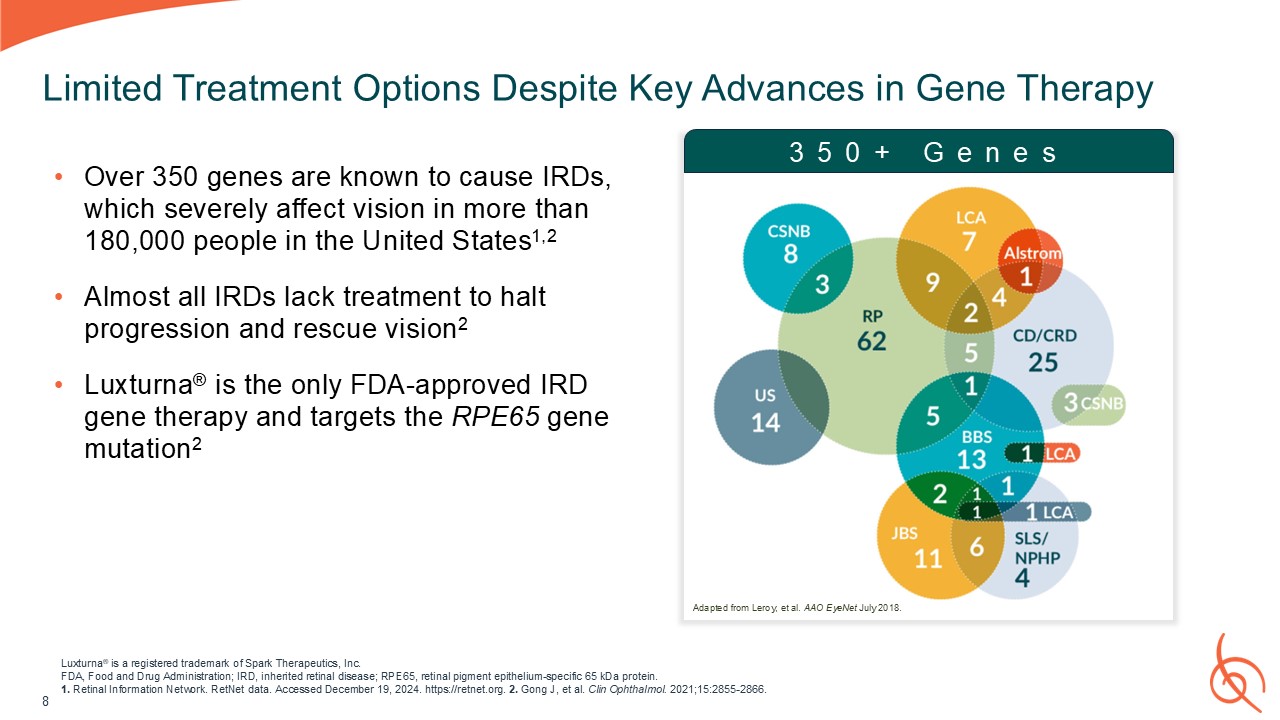
8 Over 350 genes are known to cause IRDs, which severely affect vision in more
than 180,000 people in the United States1,2 Almost all IRDs lack treatment to halt progression and rescue vision2 Luxturna® is the only FDA-approved IRD gene therapy and targets the RPE65 gene mutation2 Luxturna® is a registered trademark
of Spark Therapeutics, Inc. FDA, Food and Drug Administration; IRD, inherited retinal disease; RPE65, retinal pigment epithelium-specific 65 kDa protein. 1. Retinal Information Network. RetNet data. Accessed December 19, 2024.
https://retnet.org. 2. Gong J, et al. Clin Ophthalmol. 2021;15:2855-2866. 350+ Genes Adapted from Leroy, et al. AAO EyeNet July 2018. Limited Treatment Options Despite Key Advances in Gene Therapy
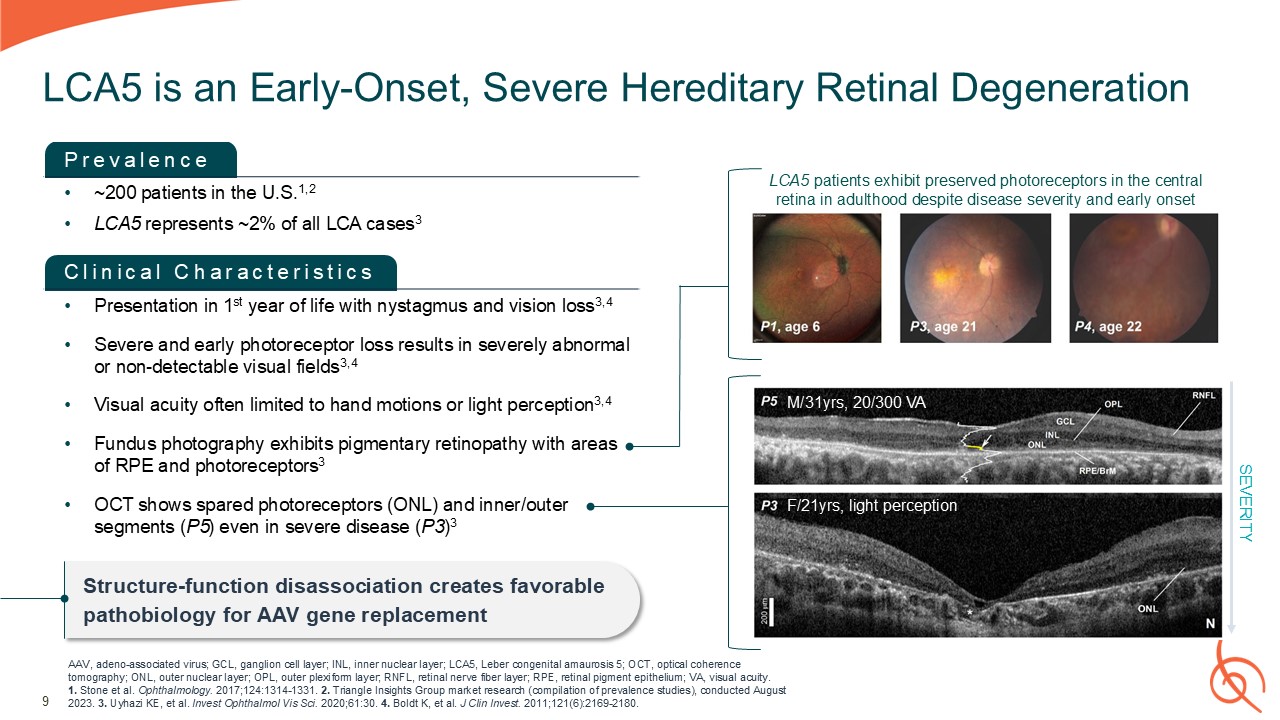
LCA5 is an Early-Onset, Severe Hereditary Retinal Degeneration
9 Prevalence ~200 patients in the U.S.1,2 LCA5 represents ~2% of all LCA cases3 Clinical Characteristics Presentation in 1st year of life with nystagmus and vision loss3,4 Severe and early photoreceptor loss results in severely
abnormal or non-detectable visual fields3,4 Visual acuity often limited to hand motions or light perception3,4 Fundus photography exhibits pigmentary retinopathy with areas of RPE and photoreceptors3 OCT shows spared photoreceptors (ONL)
and inner/outer segments (P5) even in severe disease (P3)3 SEVERITY M/31yrs, 20/300 VA F/21yrs, light perception LCA5 patients exhibit preserved photoreceptors in the central retina in adulthood despite disease severity and early
onset AAV, adeno-associated virus; GCL, ganglion cell layer; INL, inner nuclear layer; LCA5, Leber congenital amaurosis 5; OCT, optical coherence tomography; ONL, outer nuclear layer; OPL, outer plexiform layer; RNFL, retinal nerve fiber
layer; RPE, retinal pigment epithelium; VA, visual acuity. 1. Stone et al. Ophthalmology. 2017;124:1314-1331. 2. Triangle Insights Group market research (compilation of prevalence studies), conducted August 2023. 3. Uyhazi KE, et al. Invest
Ophthalmol Vis Sci. 2020;61:30. 4. Boldt K, et al. J Clin Invest. 2011;121(6):2169-2180. Structure-function disassociation creates favorable pathobiology for AAV gene replacement
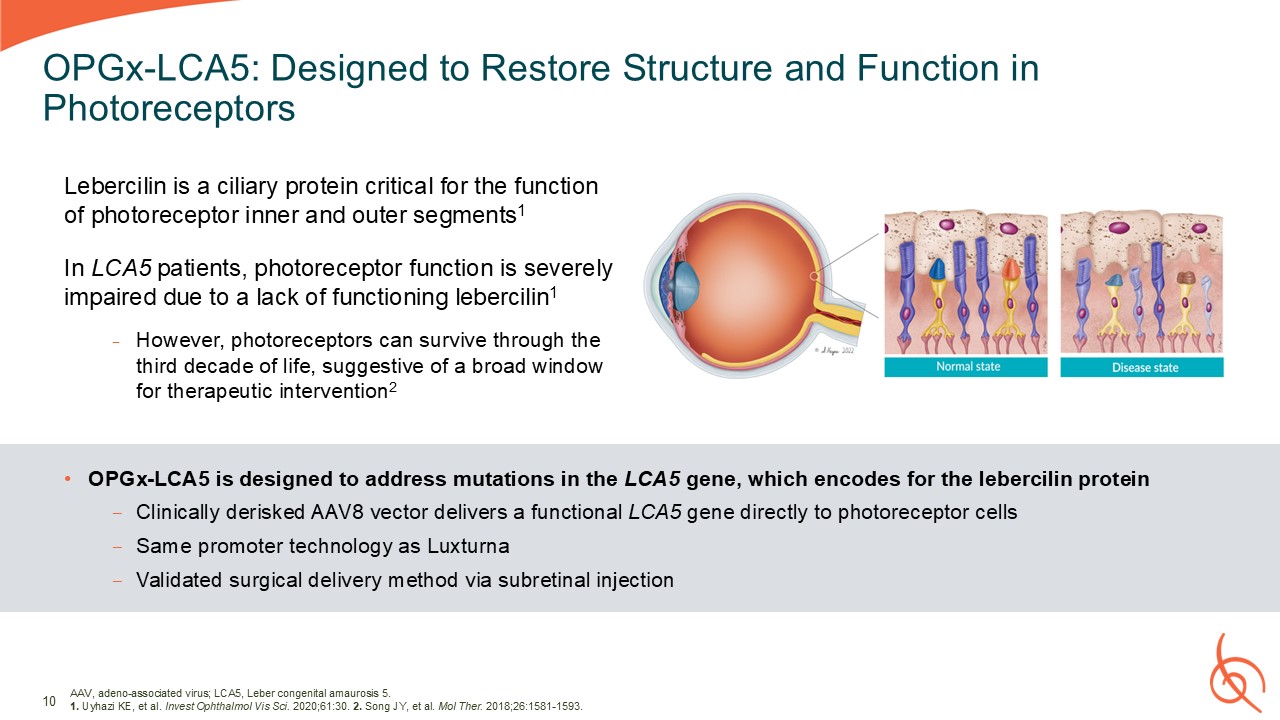
OPGx-LCA5: Designed to Restore Structure and Function in
Photoreceptors 10 Lebercilin is a ciliary protein critical for the function of photoreceptor inner and outer segments1 In LCA5 patients, photoreceptor function is severely impaired due to a lack of functioning lebercilin1 However,
photoreceptors can survive through the third decade of life, suggestive of a broad window for therapeutic intervention2 OPGx-LCA5 is designed to address mutations in the LCA5 gene, which encodes for the lebercilin protein Clinically
derisked AAV8 vector delivers a functional LCA5 gene directly to photoreceptor cells Same promoter technology as Luxturna Validated surgical delivery method via subretinal injection AAV, adeno-associated virus; LCA5, Leber congenital
amaurosis 5. 1. Uyhazi KE, et al. Invest Ophthalmol Vis Sci. 2020;61:30. 2. Song JY, et al. Mol Ther. 2018;26:1581-1593.
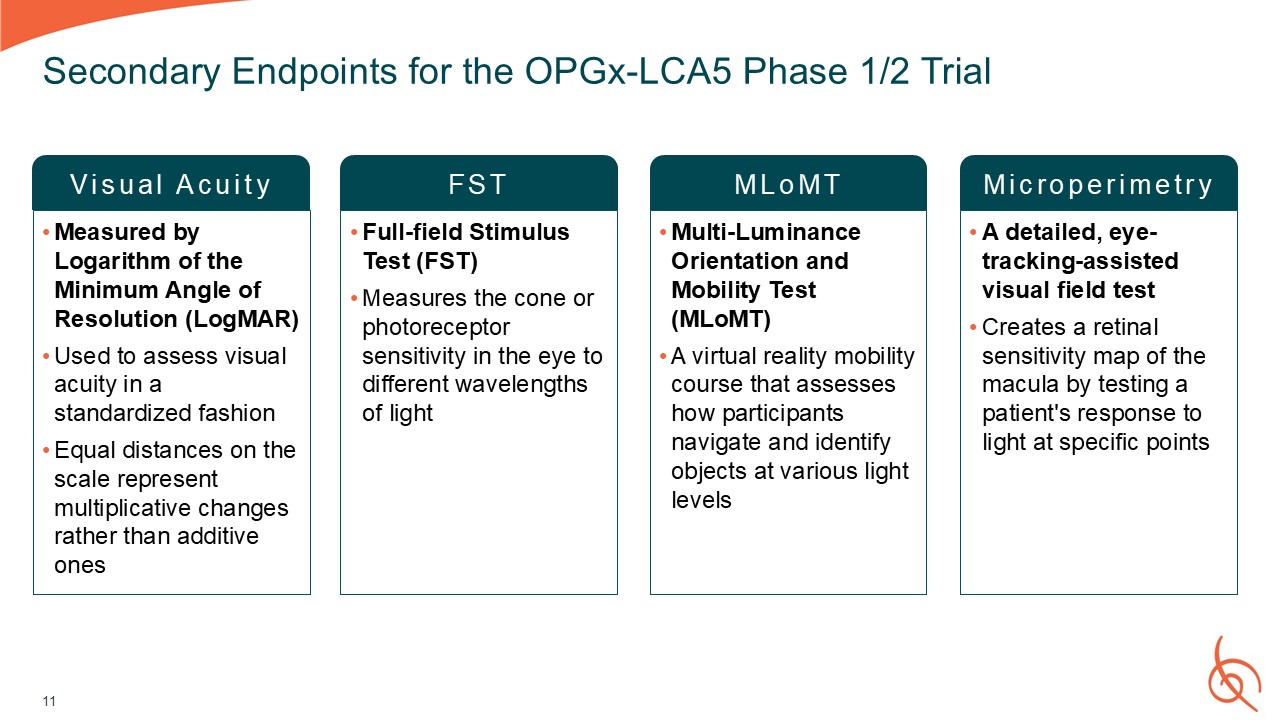
Secondary Endpoints for the OPGx-LCA5 Phase 1/2 Trial Visual Acuity Measured
by Logarithm of the Minimum Angle of Resolution (LogMAR) Used to assess visual acuity in a standardized fashion Equal distances on the scale represent multiplicative changes rather than additive ones FST Full-field Stimulus Test
(FST) Measures the cone or photoreceptor sensitivity in the eye to different wavelengths of light MLoMT Multi-Luminance Orientation and Mobility Test (MLoMT) A virtual reality mobility course that assesses how participants navigate and
identify objects at various light levels Microperimetry A detailed, eye-tracking-assisted visual field test Creates a retinal sensitivity map of the macula by testing a patient's response to light at specific points 11

12 12 OPGx-LCA5 Phase 1/2 Study DataSally Tucker, PhDSenior Vice President,
Clinical Development
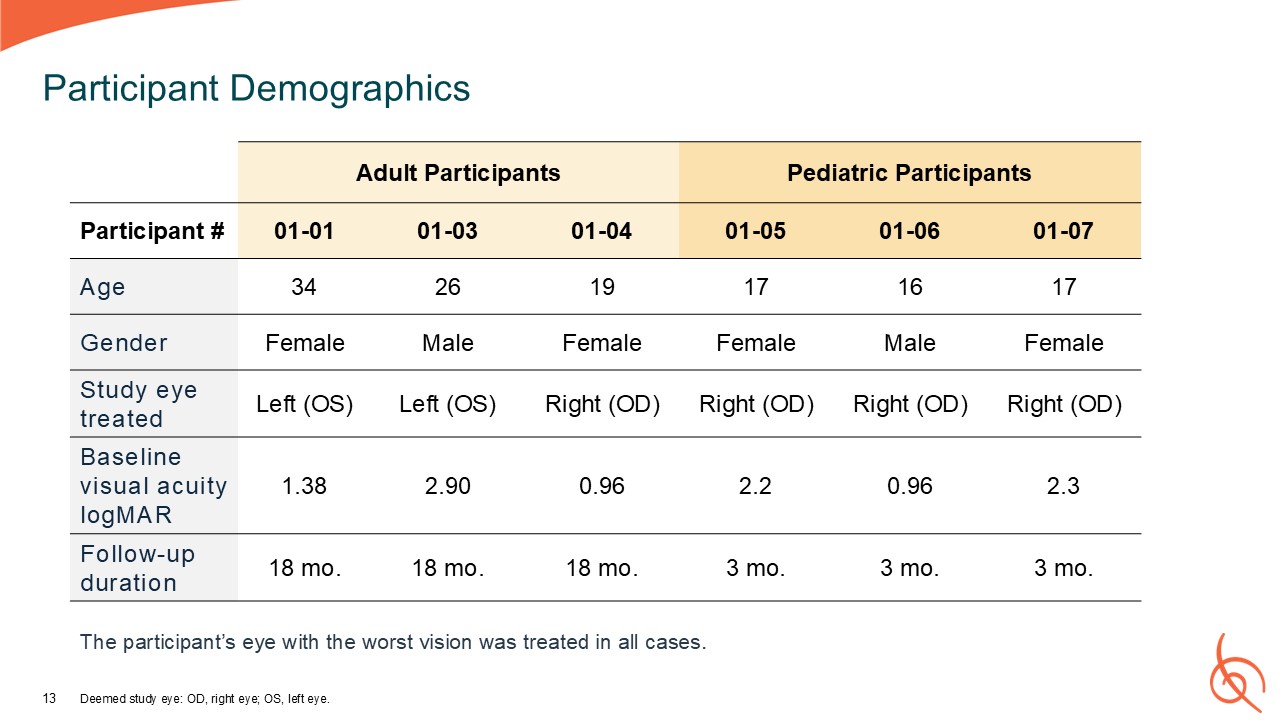
Deemed study eye: OD, right eye; OS, left eye. Participant
Demographics 13 Adult Participants Pediatric Participants Participant # 01-01 01-03 01-04 01-05 01-06 01-07 Age 34 26 19 17 16 17 Gender Female Male Female Female Male Female Study eye treated Left (OS) Left
(OS) Right (OD) Right (OD) Right (OD) Right (OD) Baseline visual acuity logMAR 1.38 2.90 0.96 2.2 0.96 2.3 Follow-up duration 18 mo. 18 mo. 18 mo. 3 mo. 3 mo. 3 mo. The participant’s eye with the worst vision was treated
in all cases.
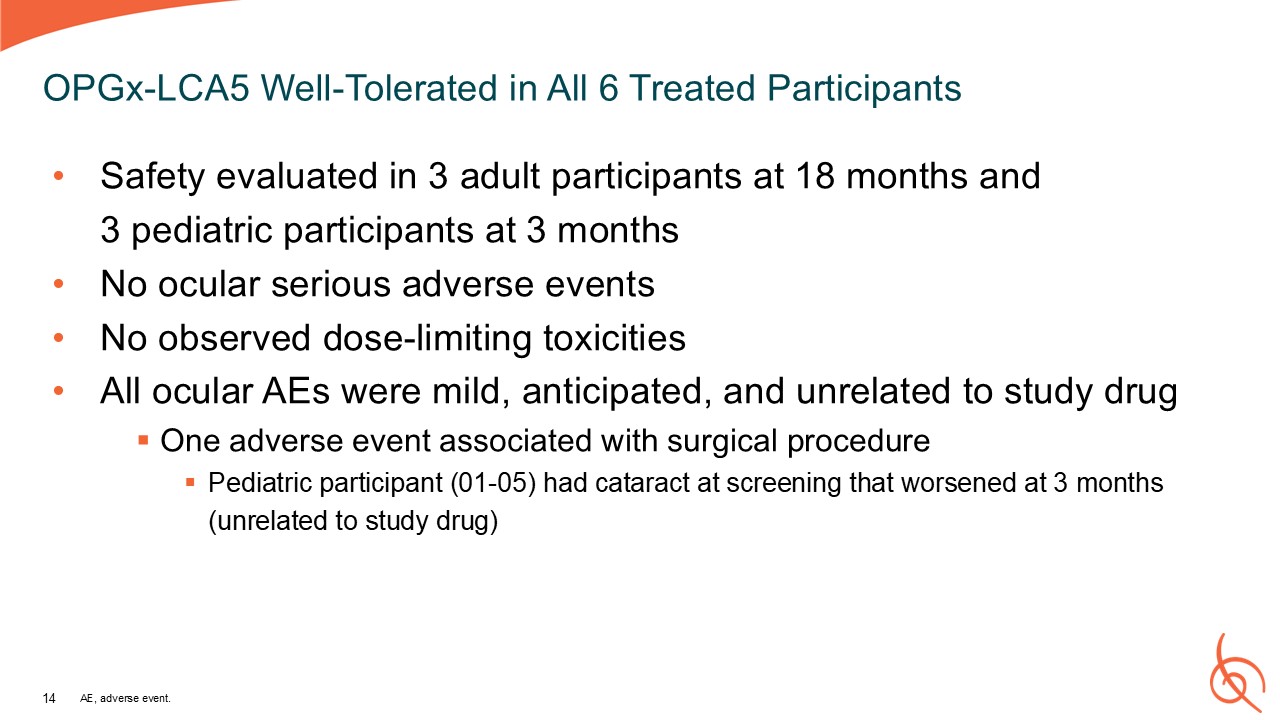
Safety evaluated in 3 adult participants at 18 months and 3 pediatric
participants at 3 months No ocular serious adverse events No observed dose-limiting toxicities All ocular AEs were mild, anticipated, and unrelated to study drug One adverse event associated with surgical procedure Pediatric participant
(01-05) had cataract at screening that worsened at 3 months (unrelated to study drug) OPGx-LCA5 Well-Tolerated in All 6 Treated Participants AE, adverse event. 14
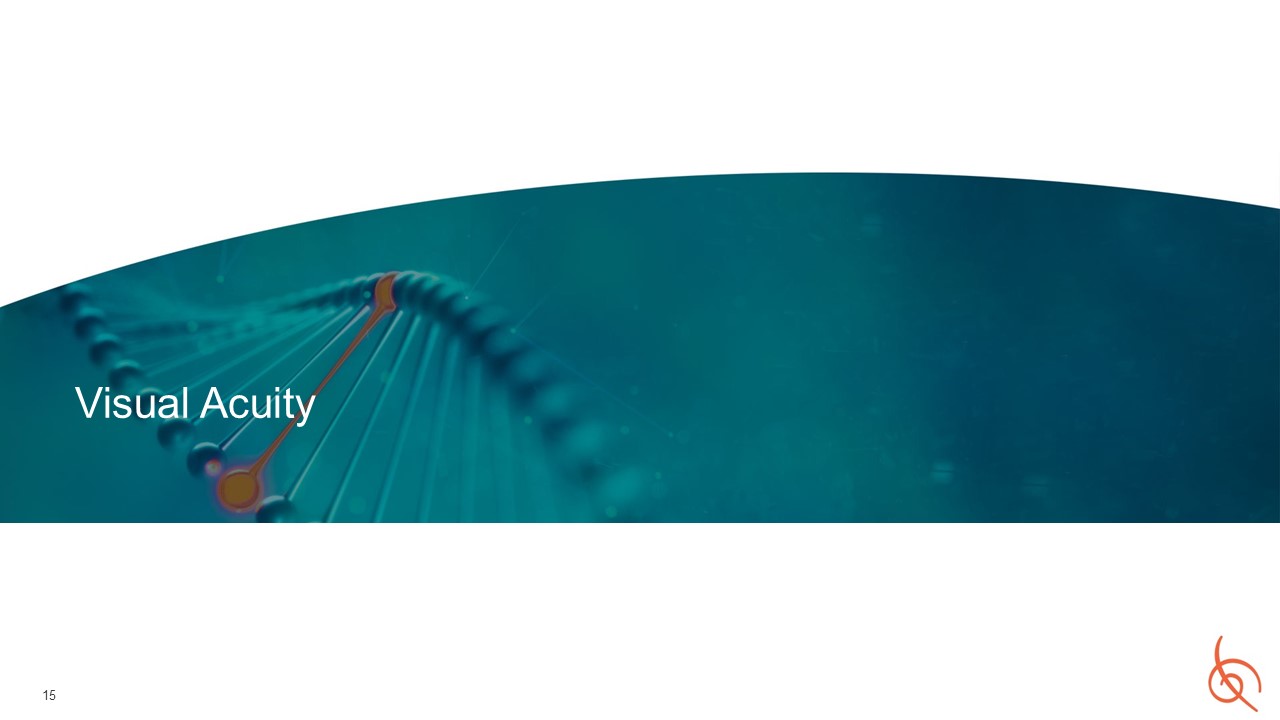
15 Visual Acuity 15
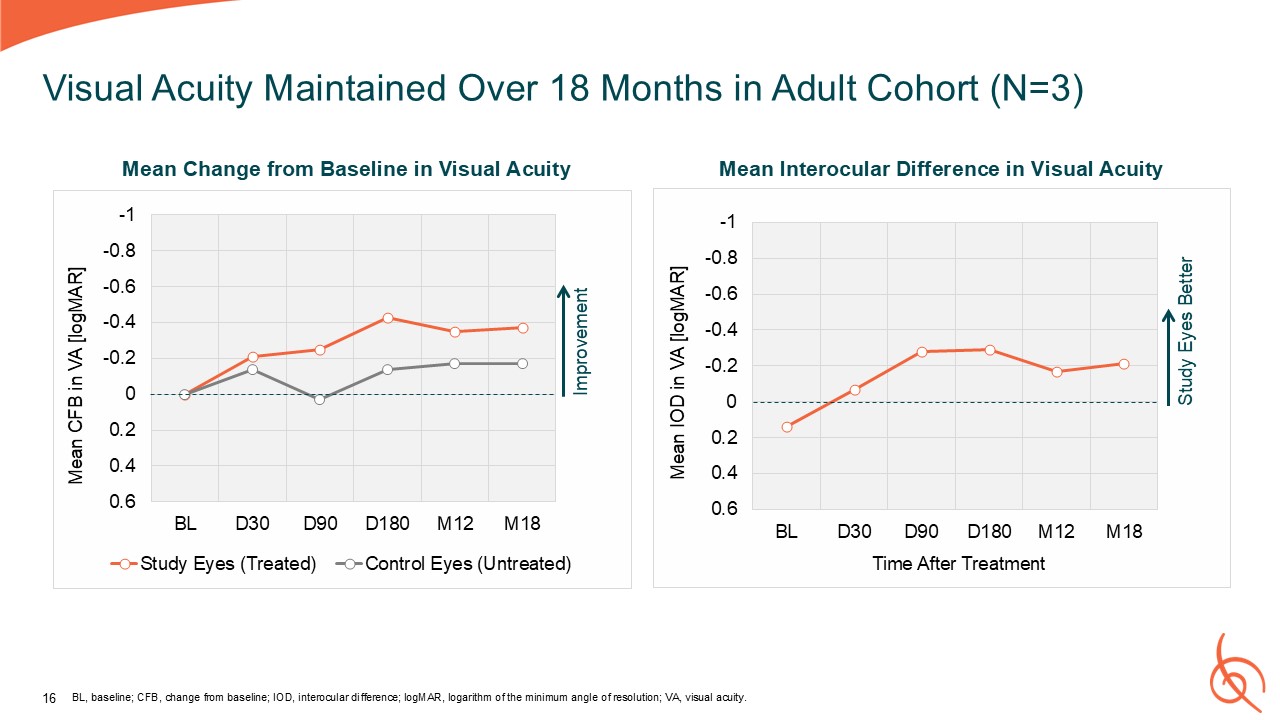
Visual Acuity Maintained Over 18 Months in Adult Cohort (N=3) BL, baseline;
CFB, change from baseline; IOD, interocular difference; logMAR, logarithm of the minimum angle of resolution; VA, visual acuity. Improvement Study Eyes Better Mean Change from Baseline in Visual Acuity Mean Interocular Difference in
Visual Acuity 16
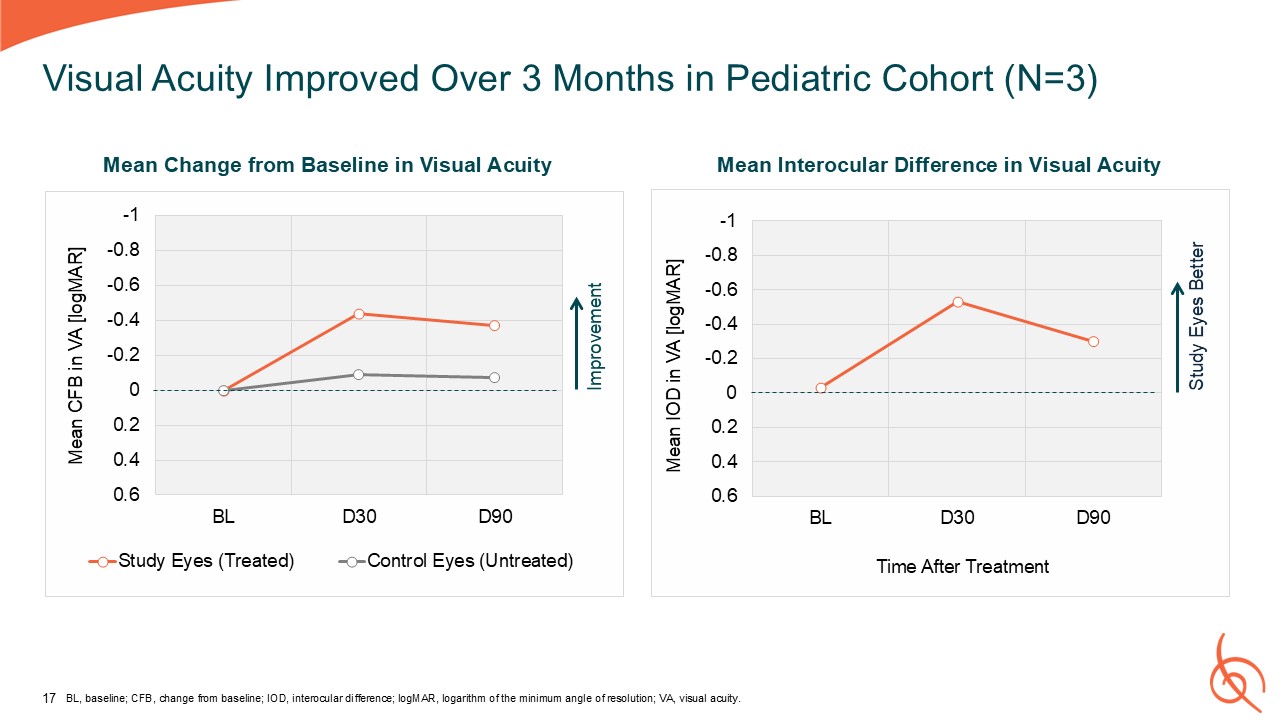
Visual Acuity Improved Over 3 Months in Pediatric Cohort (N=3) Improvement
BL, baseline; CFB, change from baseline; IOD, interocular difference; logMAR, logarithm of the minimum angle of resolution; VA, visual acuity. Study Eyes Better Mean Change from Baseline in Visual Acuity Mean Interocular Difference in
Visual Acuity 17

BL, baseline; CFB, change from baseline; logMAR, logarithm of the Minimum Angle
of Resolution; VA, visual acuity. Observed Change from Baseline in Visual Acuity (Pediatric Cohort) Participant 01-05 Participant 01-06 Participant 01-07 18
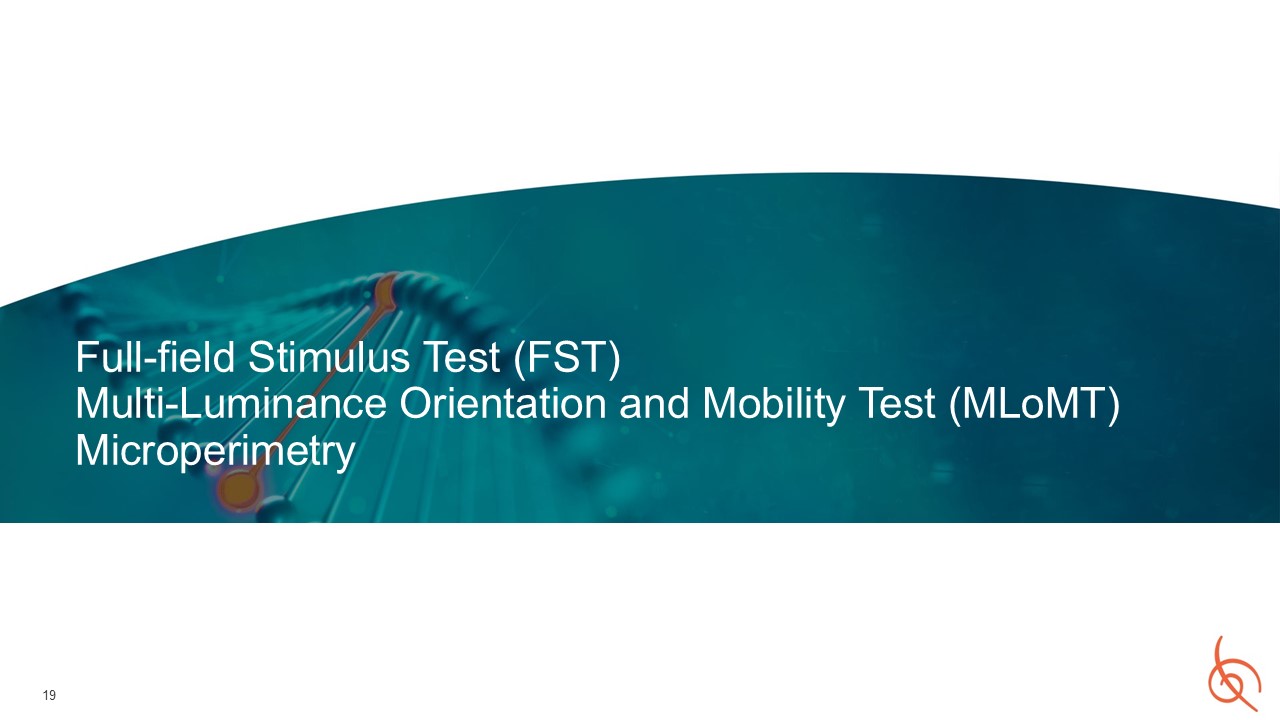
19 Full-field Stimulus Test (FST) Multi-Luminance Orientation and Mobility Test
(MLoMT)Microperimetry 19
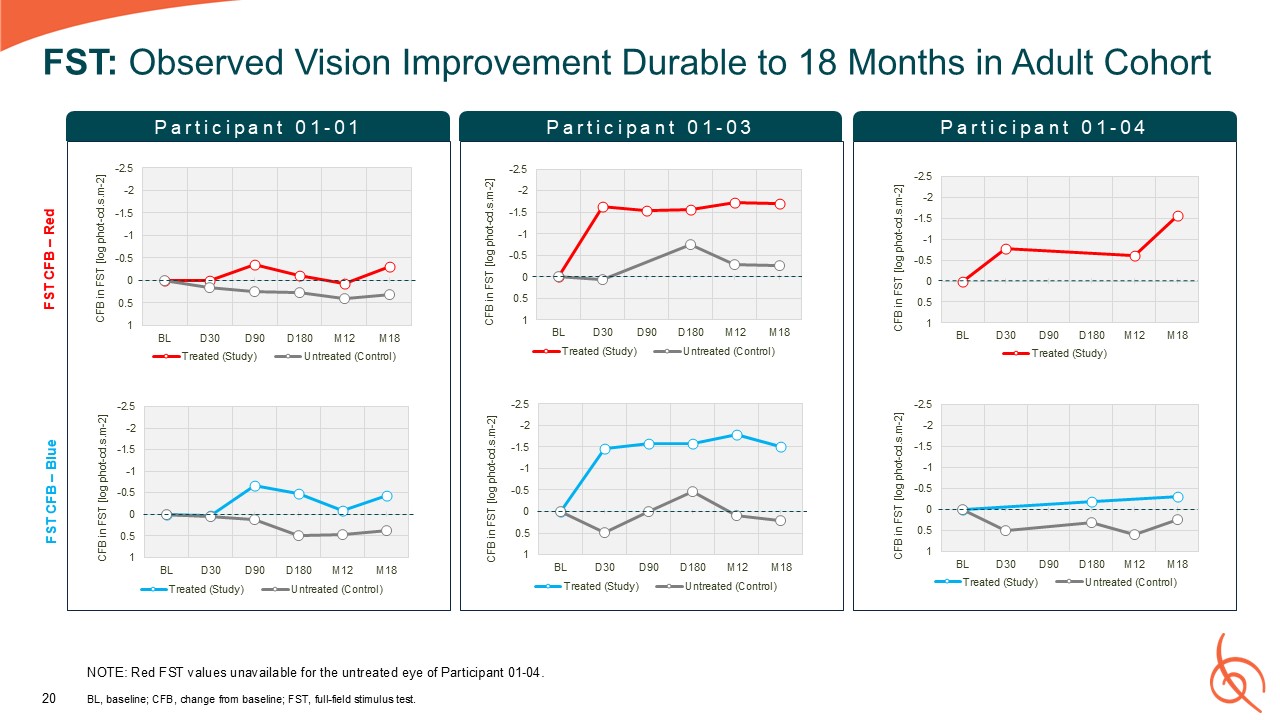
BL, baseline; CFB, change from baseline; FST, full-field stimulus test. FST:
Observed Vision Improvement Durable to 18 Months in Adult Cohort Participant 01-03 Participant 01-01 Participant 01-04 FST CFB – Red FST CFB – Blue 20 NOTE: Red FST values unavailable for the untreated eye of Participant 01-04.
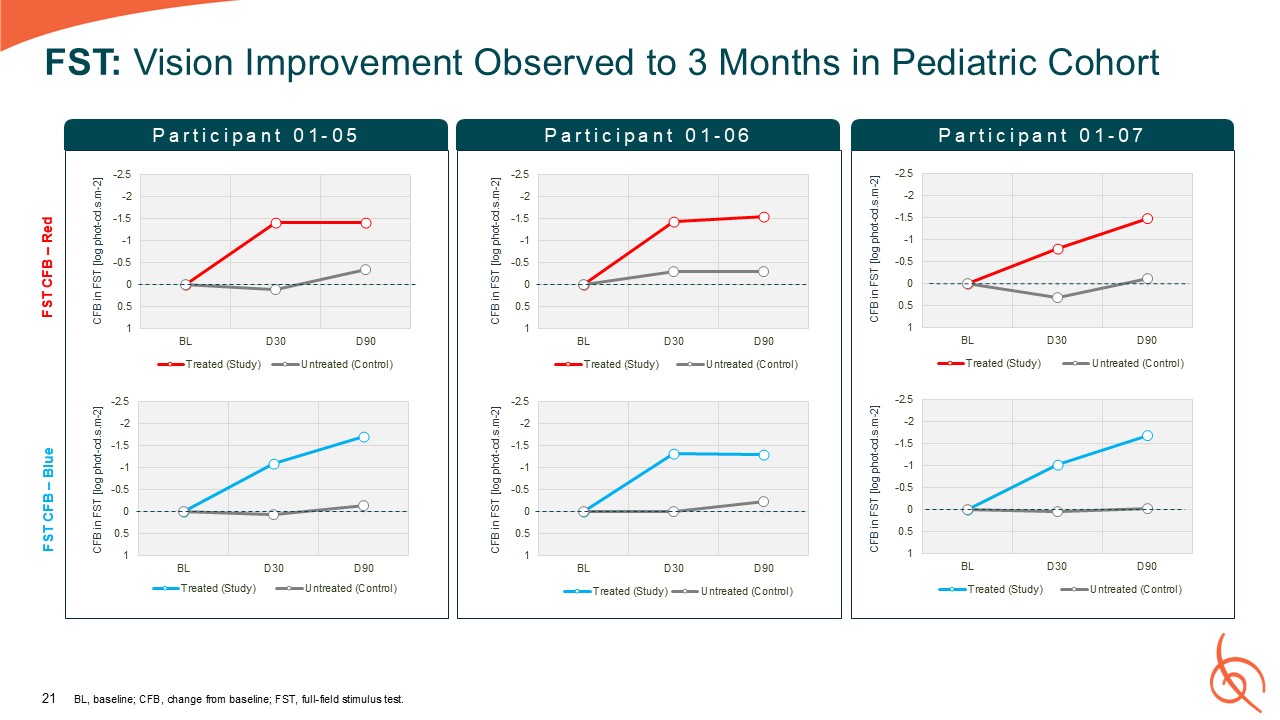
Participant 01-06 Participant 01-05 Participant 01-07 BL, baseline; CFB,
change from baseline; FST, full-field stimulus test. FST: Vision Improvement Observed to 3 Months in Pediatric Cohort FST CFB – Red FST CFB – Blue 21
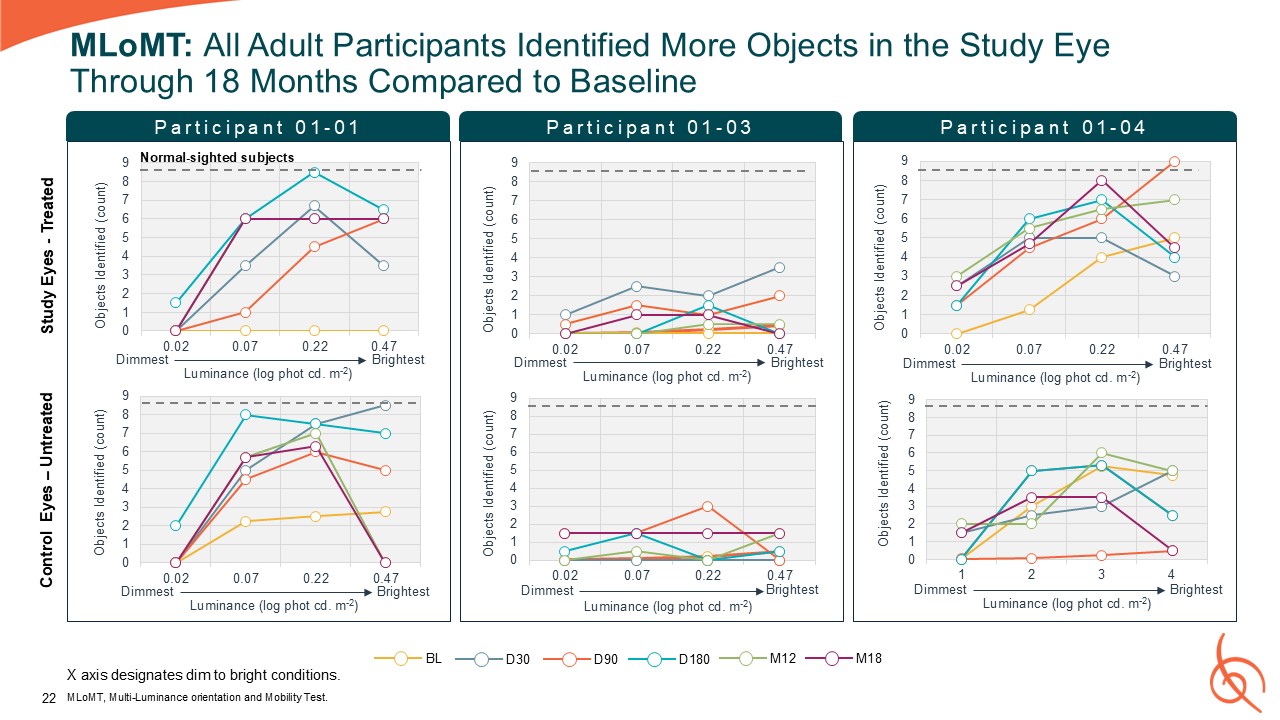
MLoMT: All Adult Participants Identified More Objects in the Study Eye Through
18 Months Compared to Baseline Participant 01-03 Participant 01-01 Participant 01-04 Control Eyes – Untreated 22 Objects Identified (count) Brightest Luminance (log phot cd. m-2) Objects Identified (count) Dimmest Normal-sighted
subjects Objects Identified (count) Study Eyes - Treated Objects Identified (count) Brightest Luminance (log phot cd. m-2) Objects Identified (count) Dimmest Objects Identified (count) MLoMT, Multi-Luminance orientation and Mobility
Test. BL D90 D180 M12 M18 D30 Brightest Luminance (log phot cd. m-2) Dimmest Brightest Luminance (log phot cd. m-2) Dimmest Brightest Luminance (log phot cd. m-2) Dimmest Brightest Luminance (log phot cd. m-2) Dimmest X
axis designates dim to bright conditions.
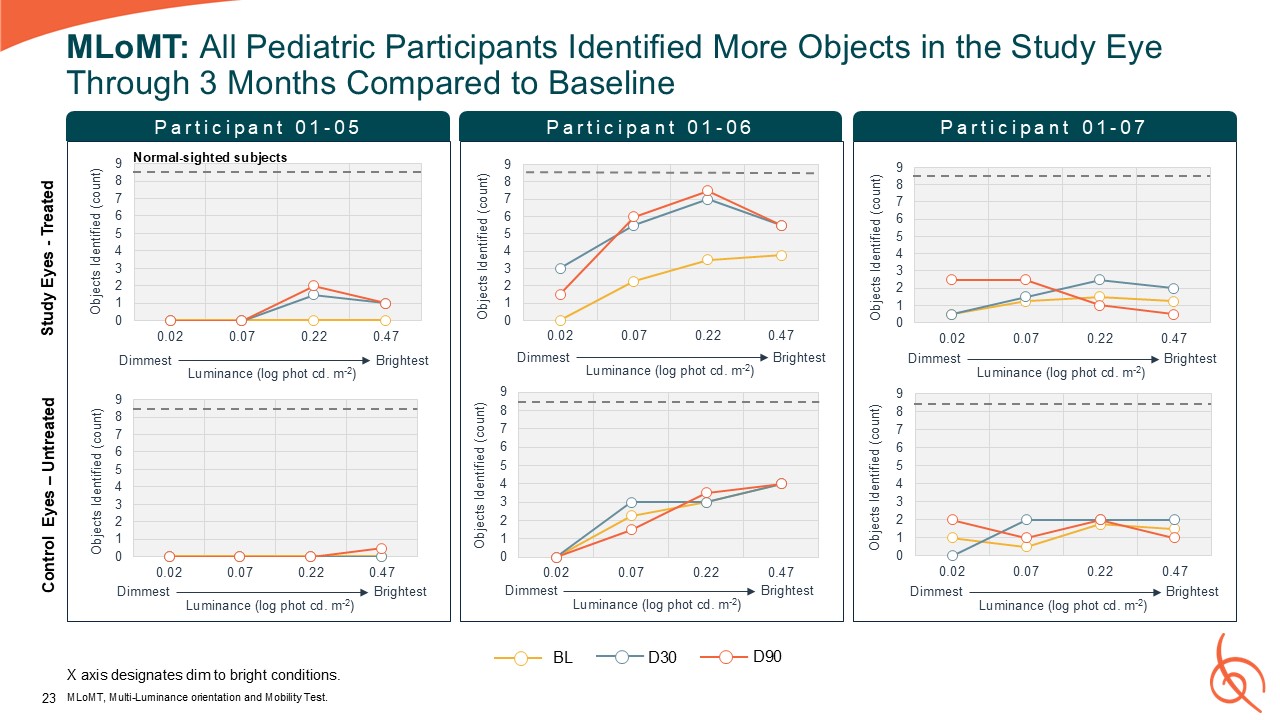
MLoMT: All Pediatric Participants Identified More Objects in the Study Eye
Through 3 Months Compared to Baseline Participant 01-06 Participant 01-05 Participant 01-07 Control Eyes – Untreated 23 Study Eyes - Treated MLoMT, Multi-Luminance orientation and Mobility Test. Objects Identified
(count) Normal-sighted subjects Objects Identified (count) Objects Identified (count) BL D90 D30 Objects Identified (count) Objects Identified (count) Objects Identified (count) Brightest Luminance (log phot cd.
m-2) Dimmest Brightest Luminance (log phot cd. m-2) Dimmest Brightest Luminance (log phot cd. m-2) Dimmest Brightest Luminance (log phot cd. m-2) Dimmest Brightest Luminance (log phot cd. m-2) Dimmest Brightest Luminance (log
phot cd. m-2) Dimmest X axis designates dim to bright conditions.
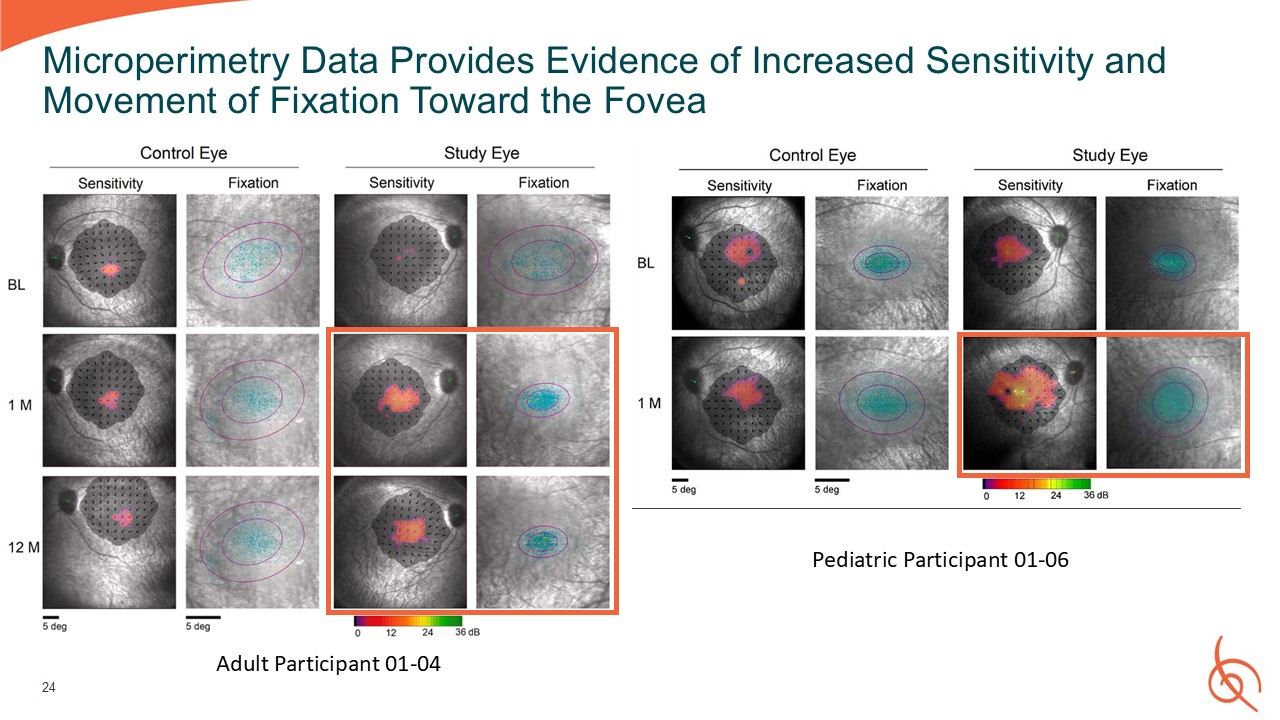
24 Microperimetry Data Provides Evidence of Increased Sensitivity and Movement
of Fixation Toward the Fovea Adult Participant 01-04 Pediatric Participant 01-06
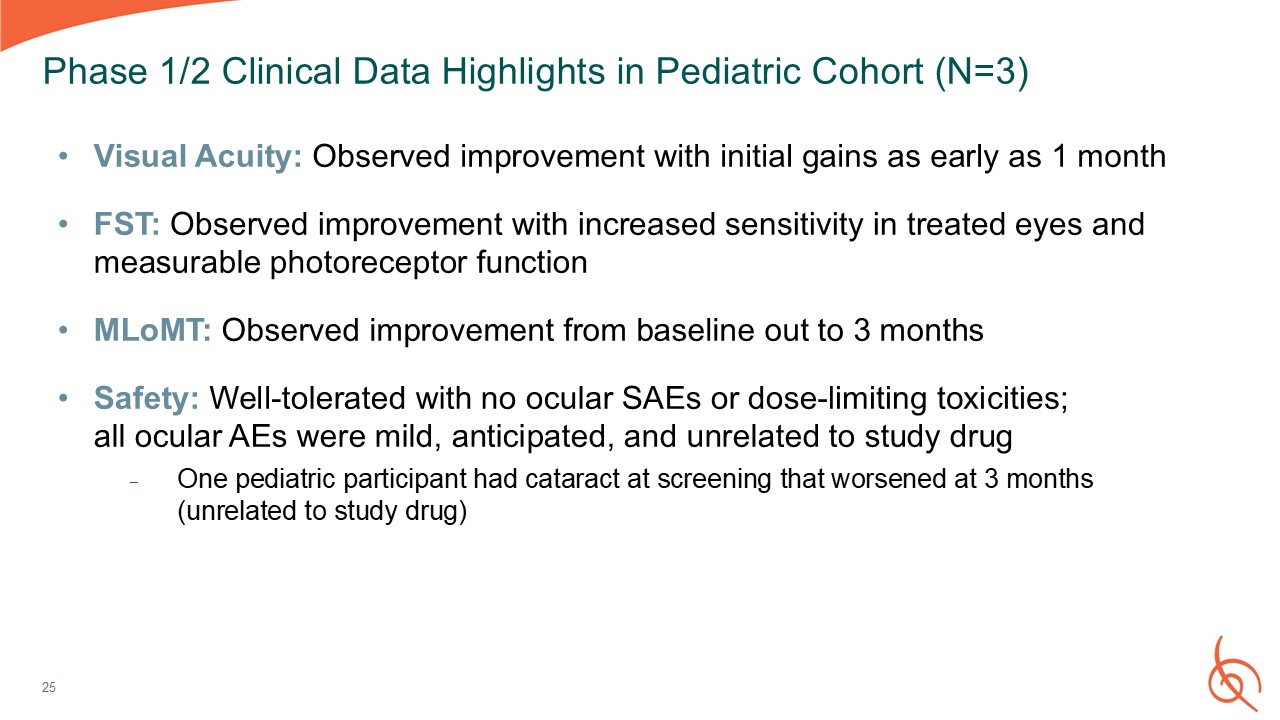
25 Phase 1/2 Clinical Data Highlights in Pediatric Cohort (N=3) Visual Acuity:
Observed improvement with initial gains as early as 1 month FST: Observed improvement with increased sensitivity in treated eyes and measurable photoreceptor function MLoMT: Observed improvement from baseline out to 3 months Safety:
Well-tolerated with no ocular SAEs or dose-limiting toxicities; all ocular AEs were mild, anticipated, and unrelated to study drug One pediatric participant had cataract at screening that worsened at 3 months (unrelated to study drug)
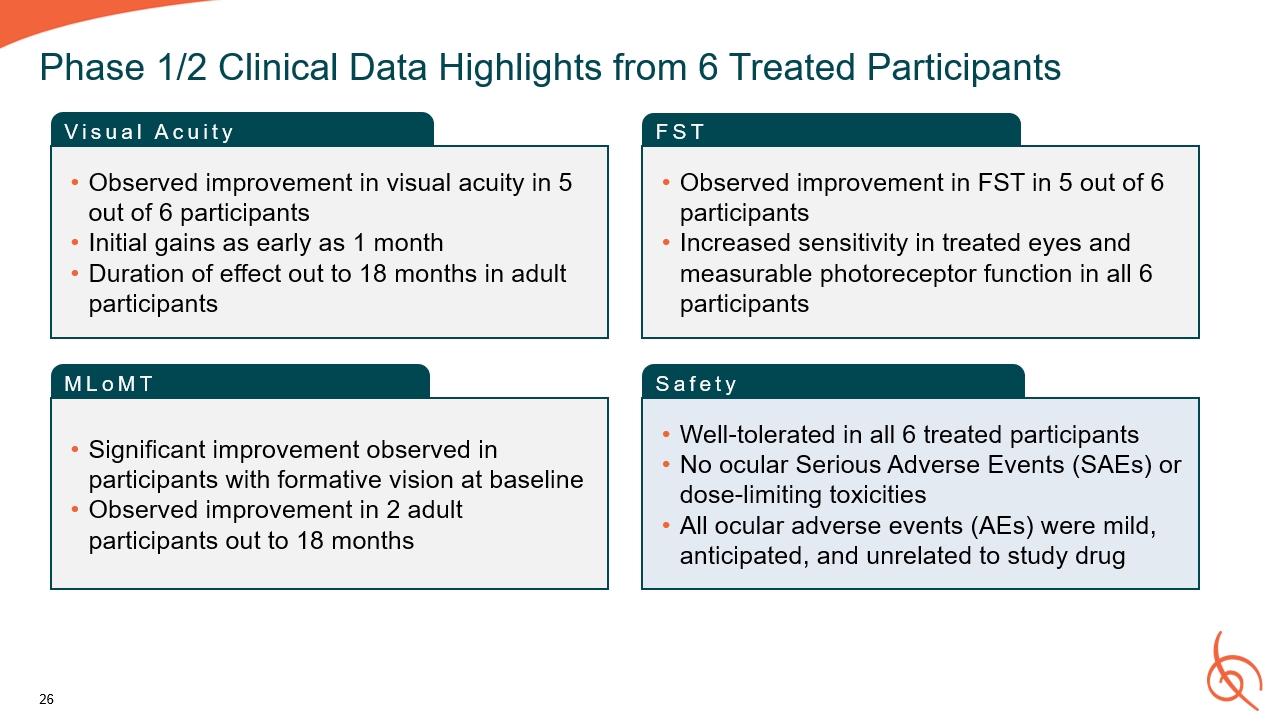
Significant improvement observed in participants with formative vision at
baseline Observed improvement in 2 adult participants out to 18 months Phase 1/2 Clinical Data Highlights from 6 Treated Participants 26 Observed improvement in visual acuity in 5 out of 6 participants Initial gains as early as 1
month Duration of effect out to 18 months in adult participants Visual Acuity MLoMT Well-tolerated in all 6 treated participants No Serious Adverse Events (SAEs) or dose-limiting toxicities All ocular adverse events (AEs) were mild,
anticipated, and unrelated to study drug Safety FST Observed improvement in FST in 5 out of 6 participants Increased sensitivity in treated eyes and measurable photoreceptor function in all 6 participants
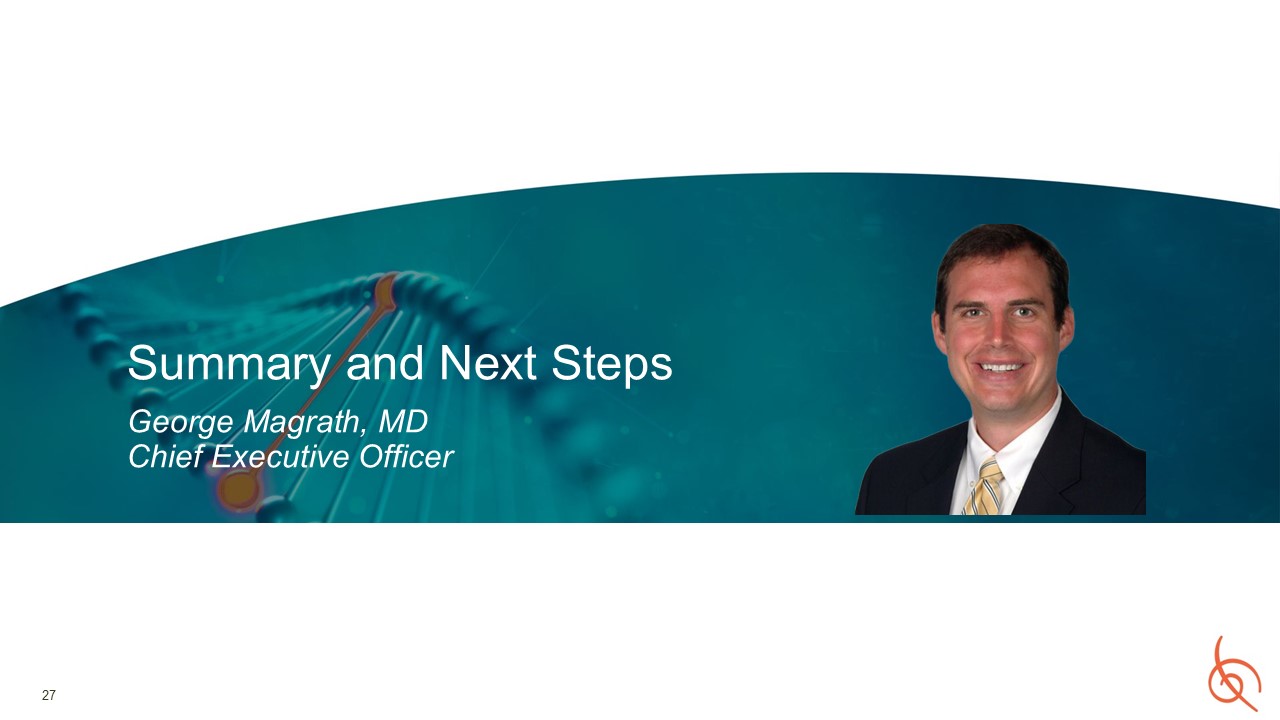
27 Summary and Next StepsGeorge Magrath, MDChief Executive Officer 27
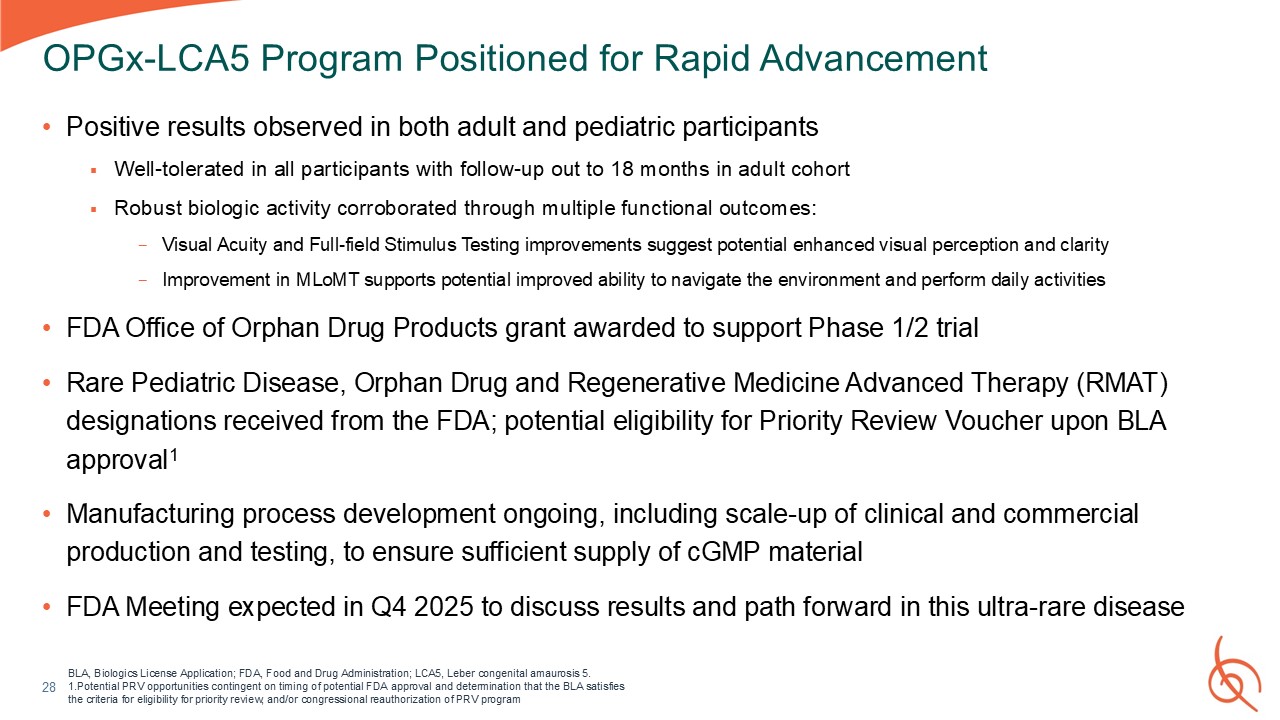
Positive results observed in both adult and pediatric
participants Well-tolerated in all participants with follow-up out to 18 months in adult cohort Robust biologic activity corroborated through multiple functional outcomes: Visual Acuity and Full-field Stimulus Testing improvements suggest
potential enhanced visual perception and clarity Improvement in MLoMT supports potential improved ability to navigate the environment and perform daily activities FDA Office of Orphan Drug Products grant awarded to support Phase 1/2 trial
Rare Pediatric Disease, Orphan Drug and Regenerative Medicine Advanced Therapy (RMAT) designations received from the FDA; potential eligibility for Priority Review Voucher upon BLA approval1 Manufacturing process development ongoing,
including scale-up of clinical and commercial production and testing, to ensure sufficient supply of cGMP material FDA Meeting expected in Q4 2025 to discuss results and path forward in this ultra-rare disease 28 OPGx-LCA5 Program
Positioned for Rapid Advancement BLA, Biologics License Application; FDA, Food and Drug Administration; LCA5, Leber congenital amaurosis 5. 1.Potential PRV opportunities contingent on timing of potential FDA approval and determination that
the BLA satisfies the criteria for eligibility for priority review, and/or congressional reauthorization of PRV program
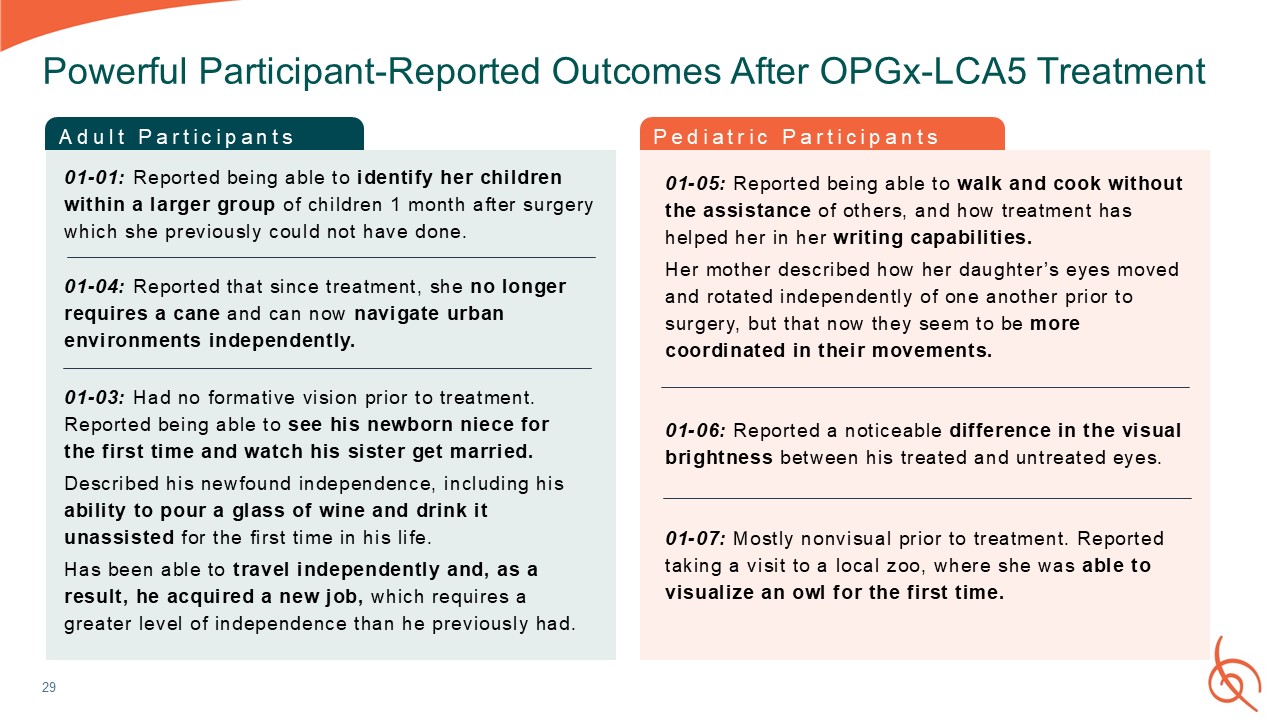
29 Powerful Participant-Reported Outcomes After OPGx-LCA5 Treatment Adult
Participants 01-01: Reported being able to identify her children within a larger group of children 1 month after surgery which she previously could not have done. 01-03: Had no formative vision prior to treatment. Reported being able to see
his newborn niece for the first time and watch his sister get married. Described his newfound independence, including his ability to pour a glass of wine and drink it unassisted for the first time in his life. Has been able to travel
independently and, as a result, he acquired a new job, which requires a greater level of independence than he previously had. 01-04: Reported that since treatment, she no longer requires a cane and can now navigate urban environments
independently. Pediatric Participants 01-05: Reported being able to walk and cook without the assistance of others, and how treatment has helped her in her writing capabilities. Her mother described how her daughter’s eyes moved and
rotated independently of one another prior to surgery, but that now they seem to be more coordinated in their movements. 01-06: Reported a noticeable difference in the visual brightness between his treated and untreated eyes. 01-07: Mostly
nonvisual prior to treatment. Reported taking a visit to a local zoo, where she was able to visualize an owl for the first time.
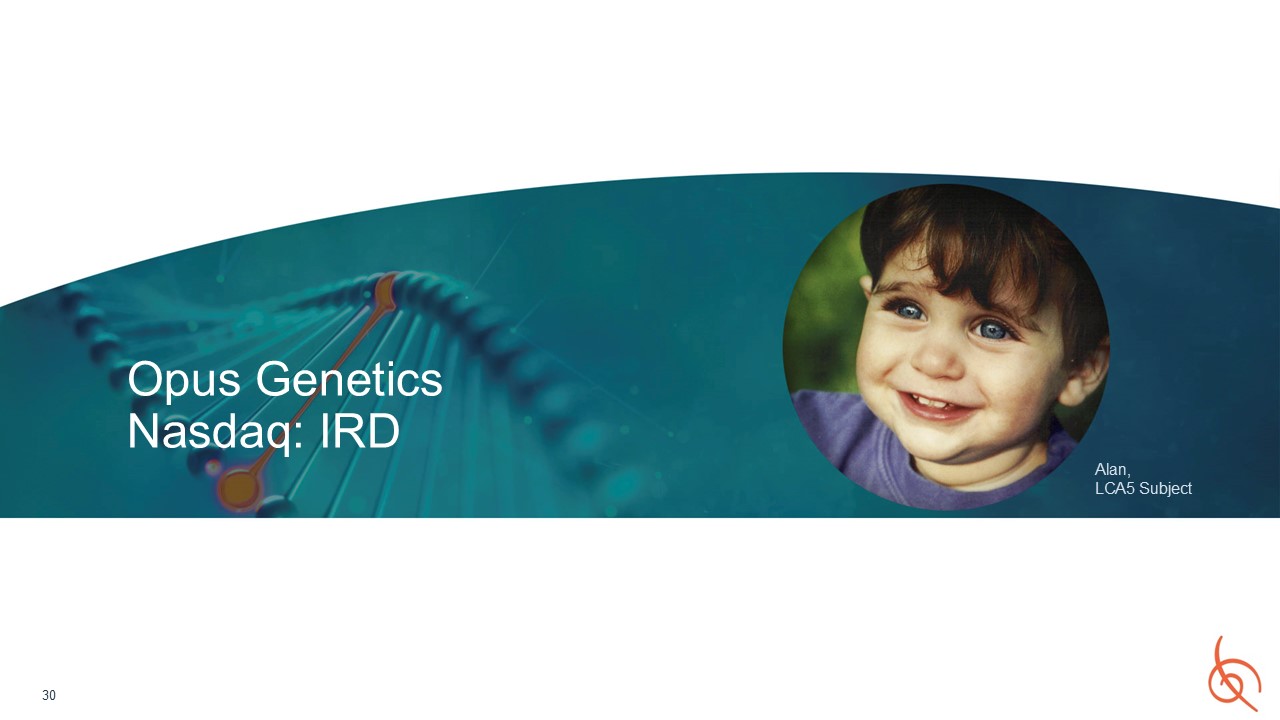
Opus GeneticsNasdaq: IRD 30